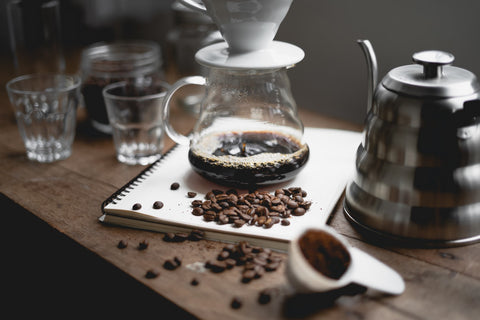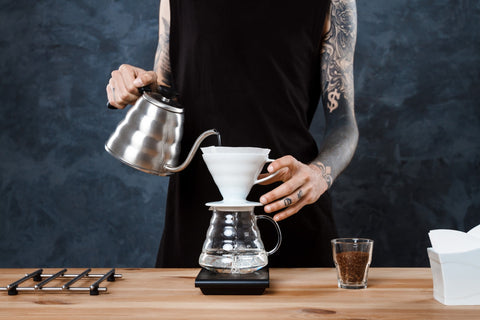How much coffee should you use for each cup of coffee?
We've all been there. You're at home, trying to make the perfect cup of coffee, but you don't want to make it too weak or too strong (and let's face it: you REALLY don't want to make it too weak!). So, how much coffee should you really use? This blog post should be a helpful guide to get you started, but eventually you'll figure out what works for you and you'll be brewing the perfect cup of coffee before you know it!
The perfect cup of coffee is a tricky thing to brew. Some people like it weak, others want it strong and some just want to be able to drink the whole pot. It can be hard enough finding the right water temperature (should you use boiling or lower temperatures?), let alone figuring out how much coffee you need to use. A lot of people in Coppell, Dallas and Fort Worth tend to ask us how much coffee they should use for each cup of coffee, so we put together this handy guide to help.

The general rule is 2 tablespoons of ground coffee per cup of coffee
When it comes to making coffee, most people usually follow the general rule of 2 tablespoons of ground coffee per cup of coffee. But if you want a stronger flavor, you can always increase the amount up to 3-4 tablespoons per cup. This will give you a more intense flavor that is perfect for those who really love their coffee (like us!).
Of course, the more coffee you use, the more time it will take to brew. So if you are in a hurry, you might want to use less coffee. But remember, the quality of your coffee will suffer. And quality is the #1 thing we're going for at Runyon Coffee.

There are helpful coffee charts online that will help you fine tune your coffee amounts
Looking for a coffee chart to help you make the perfect cup of coffee? You can find a variety of charts online that will give you different measurements and brewing times. For instance, this chart from Lifehacker goes into great detail about how much coffee you'll need, starting from how much you'll need for one cup all the way up to the recommendation for making 12 cups.
If you're really feeling scientific, we've talked with fans of our coffee and have heard over and over again that a 1:16 or 1:17 ratio of coffee:water works really, really well, especially in a pour over. When we reference this, we mean 1 gram of coffee for every 16 or 17 grams of water (or, simply 1 part coffee, 16 parts water). Bon Appetit recommends 1:16, and they seem like a pretty good source. Either way, this will at least get you started, and you can experiment from there.

The roast level of the bean can play an important role in determining how much coffee you'll need
One of the things that's very interesting about coffee is when you're roasting, you're evaporating the moisture that's held inside the bean. Even though coffee is dried before being sent to our roastery, it still contains a good bit of moisture in it, especially compared to after it comes out of the roaster. But, depending on how long you roast coffee for, you're going to have more or less moisture in the bean, which also effects how much coffee you might need to use to get the "strength" you want.
For instance, our Weekend Roast is roasted just about through first crack. That means that it still retains more moisture than our Hump Day Blend, which goes all the way through second crack. (We'll write more about what the "cracks" mean in another blog post). Put more simply, Hump Day Blend is in the roaster longer than Weekend Roast, so the heat has more time to evaporate the moisture held in the beans.
So, what this means is that you may need to use just a bit more coffee when brewing Weekend Roast than you might when brewing Hump Day Blend. Because the Hump Day Blend beans have dried out a bit more, the water can pass through the pores in the coffee grinds and extract more coffee flavor.

Your brewing method is something to consider
The ratios mentioned above are with drip coffee or pour over coffee in mind. But, how much coffee should you use if you're brewing in a French press? The answer is actually pretty similar to previous ratios mentioned above. If you want a weaker cup of coffee, go with the 2 tablespoon per cup rule. But, if you want a stronger brew, you can increase the amount of coffee you use. Again, French press is a great brewing method for experimentation, so don't be afraid to do a little trial and error.
The same goes for espresso. The rule of thumb is 1 ounce (by weight) of ground coffee per shot. We recommend doing a little bit more research on espresso preparation, so you will have to do a bit more reading and YouTube-ing to figure out how to get the perfect shot of espresso. But, we figure that if you're invested in drinking espresso at home, that will just be part of the fun of making espresso!
What about the AeroPress? We've found that the AeroPress is a great way to make a really strong cup of coffee, without all the bitterness that can sometimes come along with using a French press. The AeroPress obviously comes with a great guide to get you started (after all, they've done a TON of product research and testing), but if you've lost it, here's a link to those instructions for your reference. But, to make things super simple, the AeroPress comes with a little scoop, so you just add 1 scoop for every "cup" you're going to make, then fill up the water level to the same number of scoops that you've added.
For instance, we have the AeroPress Go because we like to bring Payday Roast with us when we travel, so we always add three scoops and then fill the chamber up to the number "3" with water, then stir. Then, of course, you add more hot water until you get your desired strength of coffee. We tend to go pretty strong when using the AeroPress, but the thing we love about it is you never seem to get any bitter notes (especially with Runyon Coffee, of course!).

It's really all about what works for you when brewing coffee
We always recommend starting with the two-tablespoons-per-cup method and adjusting from there. At the end of the day, the key to making great coffee is finding what works best for you. Some people like their coffee weak, while others want it strong. The important thing is to experiment and figure out what you like. Once you find your preferred water-to-coffee ratio, make sure you write it down so you can remember. We sometimes put sticky notes on our coffee maker to remember the exact ratio we've loved when brewing certain coffees.
